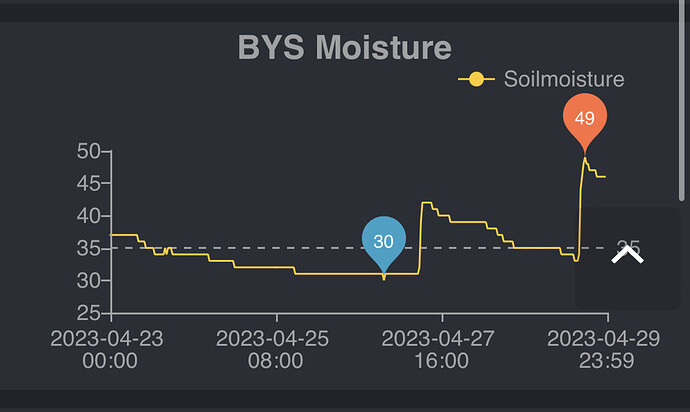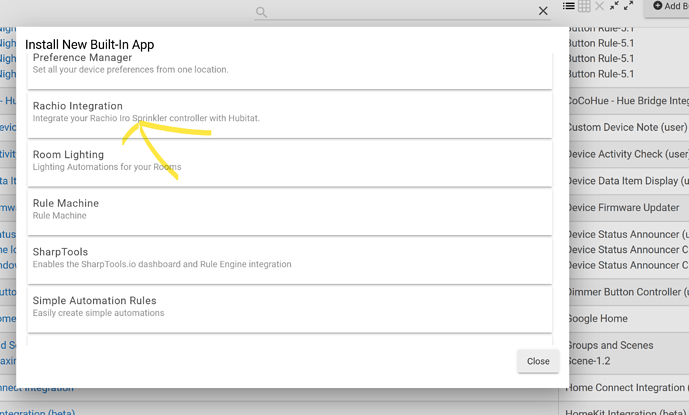I was thinking into buying aeotec water-sensor-7 to help me with my automation for my sprinkles.
I was thinking putting it 5-10 cm inside the soil and each day when it's supposed to water the garden, if it detects moisture means is raining outside to stop the sprinkles from turning on.
Anyone doing something similar to give me some feedback?
Why not get actual soil moisture sensors?
The Ecowitt rabbit hole is a a deep one. Soil moisture sensors and more.
I'm not sure that they would work well in place of real moisture sensors. I would look at this instead... https://www.amazon.com/Moisture-Temperature-Sensor-Outdoor-Waterproof-Compatible/dp/B0BWMXQH8L
Is there a Hubie driver for that?
Looks pretty nice.
It's Tuya so likely one of @kkossev 's drivers would work with it
A moisture/leak sensor is simply a contact sensor in which the contact is closed when moisture allows a conductive path across the sensor terminals. I have one working in a reservoir of water purified by reverse osmosis to 20 ppm TDS. Thus, it does not take much in the way of conductivity to complete the circuit. There is no way to calibrate the sensor, so it would not work effectively as a soil moisture sensor.
Right... In soil the soil could be extremely damp (ie too damp to want to turn on the sprinklers) but do to the soil and other factors it may not be saturated enough to set off the sensor. Moisture sensor makes more sense because you can set your threshold...(well ideally)
I would think if you're just trying to see if it's raining, you could rig something up. How about at the end of a downspout?
edit: How do the ones the sprinkler people make work?
One thing I’ve always wondered, for sensors actually intended to measure soil moisture (like Ecowitt’s for example).
What’s “wet enough” for a garden? Lawn? What’s “too dry?” In other words, I have info about soil moisture but not enough to put it into a context to do anything about it (e.g. open the hose controller some more or skip a scheduled watering).
If you had a weather station you could make some assumptions. 
You could maybe even make some assumptions based on on-line weather reporting, somehow, I bet. There'd be some skills required though, so that leaves me out.
Not sure if this helps or confuses the issue more
Excerpt about moisture sensor: This will work like radar in the soil," Windscheffel mentioned. "It measures the moisture in the radius of the sensor to about 2 or 3 inches. It can be integrated into an irrigation system where it will help make the decision whether or not the landscape needs irrigation."
I have seen many sprinkler system merrily watering lawns during the middle of a downpour. Perhaps there are newer systems that are more sophisticated.
I use a Rachio 3 combined with my Tempest. Have yet to see that happen fortunately..... In that combination case I simply have hubitat for monitoring (letting me know it's running). The actual triggering happenes between the 2 via rachios Tempest integration.
Try to keep the soil moisture no lower than 30% and no higher than 45%.
When you water, it will transiently rise as high as 75-80%, but within a couple of hours should turn to around 40%
I water (automated, off course ![]() ) every other day, and only when the ground is kind of dry. Here’s what last weeks profile looks like:
) every other day, and only when the ground is kind of dry. Here’s what last weeks profile looks like:
You like the Rachio's? I currently have a couple of standalone battery units at hose bibs. Worked for a couple of years, but always nice to be integrated with Hubitat, right?
You know, now that I think of it, I think @kkossev might have done a mini review on a zigbee watering valve. I'll have to check.
Rachio is natively supported by Hubitat  It's been pretty reliable. I'll be adding more zones soon...Right now just have 3
It's been pretty reliable. I'll be adding more zones soon...Right now just have 3
Do the summers get really dry in your neck of the woods or is it more humid?
It’s always humid ….




